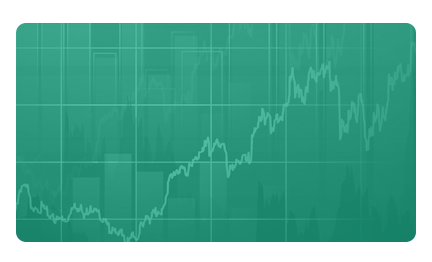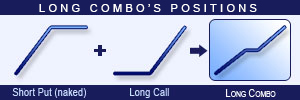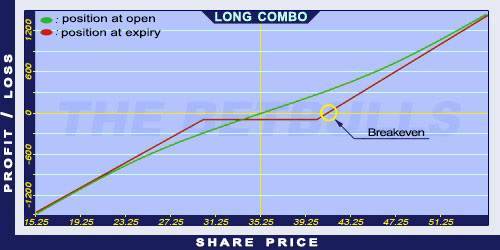Description and use
Long Combo is a synthetic strategy, because it simulates a share purchase situation. To establish the position, the trader sells lower strike Put options and purchases higher strike Call options. This investment is long-term and usually combined with other strategies. The direction of the market is bullish. The strategy is a net debit investment. The loss is limited until the price of the underlying reaches 0.
- Type: Bullish
- Transaction type: Debit
- Maximum profit: Unlimited
- Maximum loss: Limited
- Strategy: Volatility strategy
Opening the position
- Sell lower strike (OTM) Put options.
- Buy higher strike (OTM) Call options (same expiration as the Put options’).
Steps
Entry:
- Make sure the trend is ascending.
Exit:
- The strategy should simulate the purchase of an underlying security.
- The portfolio should never contain a Long option in the last month before maturity.
Basic characteristics
Maximum loss: Unlimited.
Maximum profit: Lower strike + Net debit (or - Net credit).
Time decay: Time decay has a negative effect on the value.
Breakeven point: Higher strike price (in case of net debit) + Net debit. Lower strike price (in case of net credit) - Net credit.
Advantages and disadvantages
Advantages:
- The position is similar to a normal Long position when purchasing shares, but the cost is almost 0.
- Unlimited risk in theory. In practice, the risk is limited because the share price cannot be lower than 0.
- The potential profit is unlimited.
Disadvantages:
- No dividends.
- The Bid/Offer Spread has a negative influence on the position.
Closing the position
Closing the position:
- Sell the Call options and buy back the Put options.
Mitigation of losses:
- Sell the position when the share price crosses the Stop Loss limit.
Example
ABCD is traded for $35.25 on 02.06.2017. The investor buys a Long Call option which has a strike price of $40.00, expires in November 2017. and costs $2.35 (premium). Then, sells a Short Put option which has a strike price of $30.00, expires in November 2017. and costs $1.65 (premium).
Price of the underlying (share price): S= $35.25
Premium (Long Call): C= $2.35
Premium (Short Put): P= $1.65
Strike price (Long Call): KC= $40.00
Strike price (Short Put): KP= $30.00
Net debit: ND
Maximum loss: R
Maximum profit: Pr
Breakeven point: BEP
Net debit: ND = C - P
Maximum loss (risk): R = KP + ND
Maximum profit: Unlimited
Breakeven point: BEP = KC + ND
ND = $0.70
R = $30.70
Pr = unlimited
BEP = $40.70














